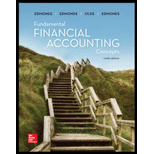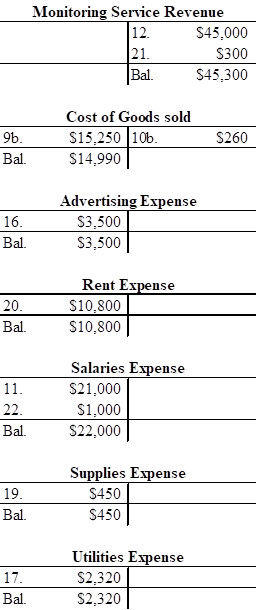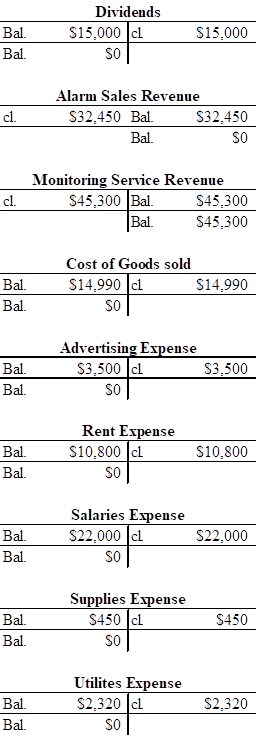
a.
Prepare the general
a.
Explanation of Solution
Journal entry:
Journal entry is a set of economic events which can be measured in monetary terms. These are recorded chronologically and systematically.
Accounting rules for Journal entries:
- To record increase balance of account: Debit assets, expenses, losses and credit liabilities, capital, revenue and gains.
- To record decrease balance of account: Credit assets, expenses, losses and debit liabilities, capital, revenue and gains.
Prepare the general journal entry of Incorporation PSS as follows:
| Event | Account titles and Explanation | Debit | Credit |
| 1. | Salaries payable | $1,500 | |
| Cash | $1,500 | ||
| (To record cash made for salaries payable) | |||
| 2. | Merchandise inventory | $5,000 | |
| Cash | $5,000 | ||
| (To record the cash purchase of inventories) | |||
| 3. | Accounts payable | $980 | |
| Cash | $980 | ||
| (To record the payment made to creditors on account) | |||
| 4. | Prepaid rent (van) | $4,800 | |
| Cash | $4,800 | ||
| (To record the payment of van rent) | |||
| 5. | Prepaid rent (office) | $7,200 | |
| Cash | $7,200 | ||
| (To record the payment of office rent) | |||
| 6. | Supplies | $500 | |
| Cash | $500 | ||
| (To record purchase of supplies) | |||
| 7. | Merchandise Inventory | $6,500 | |
| Cash | $6,500 | ||
| (To record the cash purchase of inventories) | |||
| 8. | Merchandise inventory | $7,950 | |
| Accounts payable | $7,950 | ||
| (To record the purchase of inventories on account) | |||
| 9a. | $22,000 | ||
| Cash | $11,000 | ||
| Alarm sales revenue | $33,000 | ||
| (To record the alarm sales revenue earned by cash and on account) | |||
| 9b. | Cost of goods sold | $15,250 | |
| Merchandise inventory | $15,250 | ||
| (To record the adjustment from cost to market value for inventory write-downs) | |||
| 10a. | Alarm Sales Revenue | $550 | |
| Cash | $550 | ||
| (To record revenue refunded to the customer who returned the inventory sold) | |||
| 10b. | Merchandise inventory | $260 | |
| Cost of goods sold | $260 | ||
| (To record the sales return) | |||
| 11. | Salaries expense | $21,000 | |
| Cash | $21,000 | ||
| (To record salaries expense) | |||
| 12. | Accounts payable | $45,000 | |
| Monitoring Service revenue | $45,000 | ||
| (To record services rendered on account) | |||
| 13. | Cash | $1,200 | |
| Unearned revenue | $1,200 | ||
| (To record the unearned service revenue) | |||
| 14. | Cash | $74,000 | |
| Accounts receivable | $74,000 | ||
| (To record the cash collected from accounts receivable) | |||
| 15. | Accounts payable | $6,000 | |
| Cash | $6,000 | ||
| (To record the payment made to creditors on account) | |||
| 16. | Advertising expense | $3,500 | |
| Cash | $3,500 | ||
| (To record the advertising expense) | |||
| 17. | Utilities expense | $2,320 | |
| Cash | $2,320 | ||
| (To record the utilities expense) | |||
| 18. | Dividends | $15,000 | |
| Cash | $15,000 | ||
| (To record the dividends paid) | |||
| 19. | Supplies expense | $450 | |
| Supplies | $450 | ||
| (To record |
|||
| 20. | Rent expense | $10,800 | |
| Prepaid rent | $10,800 | ||
| (To adjust the prepaid rent) | |||
| 21. | Unearned revenue | $300 | |
| Monitoring service revenue | $300 | ||
| (To record the monitoring service revenue earned) | |||
| 22. | Salaries expense | $1,000 | |
| Salaries payable | $1,000 | ||
| (To record salaries expense) |
Table (1)
Working notes:
Calculate merchandise inventory on 1/15.
Calculate merchandise inventory on 8/1.
Calculate merchandise inventory on 9/5.
Calculate total cost of goods sold.
| Particulars | Units (A) | Per unit (B) | Amount (A×B) |
| Beginning inventory | 9 | $240 | $2,160 |
| Add: Inventory purchased (1/15) | 20 | $250 | $5,000 |
| Inventory purchased (8/1) | 25 | $260 | $6,500 |
| Inventory purchased | 6 | $265 | $1,590 |
| Total cost of goods sold | 60 | $15,250 |
Table (2) (4)
Calculate supplies expense.
 (5)
(5)
Calculate rent expense.
Calculate Expired van lease payment.
Calculate expired office rent payment for year 4 and year 5.
Calculate unearned revenue.
b.
Post the transactions of T-Accounts for Incorporation PSS.
b.
Explanation of Solution
T-account:
T-account is the form of the ledger account, where the journal
The components of the T-account are as follows:
a) The title of the account
b) The left or debit side
c) The right or credit side
Post the transactions of T-Accounts for Incorporation PSS as follows:

Figure (1)

Figure (2)

Figure (3)
c.
Prepare trail balance of Incorporation PSS.
c.
Explanation of Solution
A trial balance is the summary of all the ledger accounts. The trial balance is prepared to check the total balance of the debit column with the total of the balance of the credit column, which must be equal. The trial balance is usually prepared to check accuracy of ledger accounts balances before the preparation of financial statements.
Prepare trail balance of Incorporation PSS as follows:
| Incorporation PSS | ||
| Trail Balance | ||
| December 31, Year 5 | ||
| Particulars | Debit | Credit |
| Cash | $74,210 | |
| Accounts Receivable | $13,500 | |
| Supplies | $200 | |
| Prepaid rent | $3,200 | |
| Merchandise inventory | $6,620 | |
| Land | $4,000 | |
| Accounts Payable | $1,950 | |
| Unearned revenue | $900 | |
| Salaries payable | $1,000 | |
| Common stock | $50,000 | |
| $39,190 | ||
| Dividends | $15,000 | |
| Alarm sales revenue | $32,450 | |
| Monitoring service revenue | $45,300 | |
| Cost of goods sold | $14,990 | |
| Advertising expense | $3,500 | |
| Rent expense | $10,800 | |
| Salaries expense | $22,000 | |
| Supplies expense | $450 | |
| Utilities expense | $2,320 | |
| Total | $170,790 | $170,790 |
Table (3)
d.
Prepare an income statement, statement of changes in
d.
Explanation of Solution
Income statement:
Income statement is a financial statement that shows the net income or net loss by deducting the expenses from the revenues and vice versa.
Prepare the income statement of Incorporation PSS as follows:
| Incorporation PSS | ||
| Income Statement | ||
| December 31, Year 5 | ||
| Particulars | Amount | Amount |
| Revenues: | ||
| Monitoring Service Revenue | $45,300 | |
| Alarm Sales Revenue | $32,450 | |
| Total Revenues | $77,750 | |
| Less: Cost of goods sold | $14,990 | |
| Gross margin | $62,760 | |
| Less: Expenses: | ||
| Advertising expense | $3,500 | |
| Rent expense | $10,800 | |
| Salaries expense | $22,000 | |
| Supplies expense | $450 | |
| Utilities expense | $2,320 | |
| Total Operating expenses | $39,070 | |
| Net operating income | $23,690 | |
| Less: Income tax expense | $0 | |
| Net income | $23,690 | |
Table (4)
Statement of changes in Stockholder’s equity:
This statement reports the beginning stockholders’ equity and all the changes, which led to ending stockholders’ equity. Additional capital, net income from income statement is added to and drawings are deducted from beginning stockholders’ equity to arrive at the result, ending stockholders’ equity.
Prepare the statement of changes in stockholders’ equity of Incorporation PSS as follows:
| Incorporation PSS | ||
| Statement of Changes in Stockholders' Equity | ||
| December 31, Year 5 | ||
| Particulars | Amount | Amount |
| Opening Common stock | $50,000 | |
| Add: Issue of common stock | $0 | |
| Ending common stock | $50,000 | |
| Opening retained earnings | $39,190 | |
| Add: Net income | $23,690 | |
| Less: Dividends | $15,000 | |
| Ending retained earnings | $47,880 | |
| Total stockholders' equity | $97,880 | |
Table (5)
Balance Sheet:
Balance Sheet summarizes the assets, the liabilities, and the Shareholder’s equity of a company at a given date. It is also known as the statement of financial status of the business.
Prepare the Balance sheet of Incorporation PSS as follows:
| Incorporation PSS | ||
| Balance Sheet | ||
| December 31, Year 5 | ||
| Particulars | Amount | Amount |
| Assets: | ||
| Cash | $74,210 | |
| Accounts receivable | $13,500 | |
| Supplies | $200 | |
| Prepaid rent | $3,200 | |
| Merchandise inventory | $6,620 | |
| Land | $4,000 | |
| Total Assets | $101,730 | |
| Liabilities | ||
| Accounts payable | $1,950 | |
| Salaries payable | $1,000 | |
| Unearned revenue | $900 | |
| Total liabilities | $3,850 | |
| Stockholders' Equity | ||
| Common stock | $50,000 | |
| Retained earnings | $47,880 | |
| Total stockholders' equity | $97,880 | |
| Total liabilities and Stockholders' equity | $101,730 | |
Table (6)
Statement of cash flows:
Statement of cash flows reports all the cash transactions which are responsible for inflow and outflow of cash and result of these transactions is reported as ending balance of cash at the end of reported period.
Prepare the statement of cash flows for Incorporation PSS as follows:
| Incorporation PSS | ||
| Statement of Cash Flows | ||
| December 31, Year 5 | ||
| Particulars | Amount | Amount |
| Cash flows from Operating Activities: | ||
| Cash receipts from customers | $85,650 | |
| Cash payment for expenses | ($59,300) | |
| Net cash flow from Operating Activities | $26,350 | |
| Cash flow from Investing Activities: | ||
| Cash flow from Financing Activities: | ||
| Cash payments for dividends | ($15,000) | |
| Net cash flow from Financing Activities | ($15,000) | |
| Net increase in cash | $11,350 | |
| Add: Opening cash balance | $62,860 | |
| Ending cash balance | $74,210 | |
Table (7)
Working notes:
Calculate total cash from customers.
| Particulars | Amount |
| Net sales | $11,650 |
| Add: Collection of Accounts Receivable | $74,000 |
| Total cash from customers | $85,650 |
Table (8) (11)
Calculate total cash payment for expenses.
| Particulars | Amount |
| Payment of prepaid rent | $12,000 |
| Payment of salaries | $22,500 |
| Payment of accounts payable | $6,980 |
| Payment of advertising | $3,500 |
| Payment for Supplies | $500 |
| Payment for utilities | $2,320 |
| Payment for Inventory | $11,500 |
| Total cash payment for expenses | $59,300 |
Table (9) (12)
e.
Prepare to close the temporary accounts to retained earnings of Incorporation PSS.
e.
Explanation of Solution
Closing entries:
Closing entries are recorded in order to close the temporary accounts such as incomes and expenses by transferring them to the permanent accounts. It is passed at the end of the accounting period, to transfer the final balance.
Prepare to close the temporary accounts to retained earnings of Incorporation PSS as follows:
| Date | Account titles and Explanation | Debit | Credit |
| December 31 | Alarm sales revenue | $32,450 | |
| Monitoring service revenue | $45,300 | ||
| Retained earnings | $77,750 | ||
| (To close all revenue accounts) | |||
| December 31 | Retained earnings | $54,060 | |
| Cost of goods sold | $14,990 | ||
| Advertising expense | $3,500 | ||
| Rent expense | $10,800 | ||
| Salaries expense | $22,000 | ||
| Supplies expense | $450 | ||
| Utilities expense | $2,320 | ||
| (To close all expenses accounts) | |||
| December 31 | Retained earnings | $15,000 | |
| Dividends | $15,000 | ||
| (To record dividend account) |
Table (10)
f.
Post the closing entries to the T-Accounts and prepare an after closing trail balance of Incorporation PSS.
f.
Explanation of Solution
Post-Closing Trial Balance:
After passing all the journal entries and the closing entries of the permanent accounts and then further posting them to each of the respective accounts, a post-closing trial balance is prepared which consists of a list of all the permanent accounts. A post-closing trial balance serves as an evidence to prove that the balance of the permanent accounts is equal.
Post the closing entries to the T- Accounts of Incorporation PSS as follows:

Figure (4)

Figure (5)
Prepare post -closing trail balance of Incorporation PSS as follows:
| Incorporation PSS | ||
| Post - Closing Trail Balance | ||
| December 31, Year 5 | ||
| Particulars | Debit | Credit |
| Cash | $74,210 | |
| Accounts receivable | $13,500 | |
| Supplies | $200 | |
| Prepaid Rent | $3,200 | |
| Merchandise Inventory | $6,620 | |
| Land | $4,000 | |
| Accounts payable | $1,950 | |
| Salaries Payable | $1,000 | |
| Unearned revenue | $900 | |
| Common stock | $50,000 | |
| Retained earnings | $47,880 | |
| Totals | $101,730 | $101,730 |
Table (11)
Want to see more full solutions like this?
Chapter 5 Solutions
Fundamental Financial Accounting Concepts

 AccountingAccountingISBN:9781337272094Author:WARREN, Carl S., Reeve, James M., Duchac, Jonathan E.Publisher:Cengage Learning,
AccountingAccountingISBN:9781337272094Author:WARREN, Carl S., Reeve, James M., Duchac, Jonathan E.Publisher:Cengage Learning, Accounting Information SystemsAccountingISBN:9781337619202Author:Hall, James A.Publisher:Cengage Learning,
Accounting Information SystemsAccountingISBN:9781337619202Author:Hall, James A.Publisher:Cengage Learning, Horngren's Cost Accounting: A Managerial Emphasis...AccountingISBN:9780134475585Author:Srikant M. Datar, Madhav V. RajanPublisher:PEARSON
Horngren's Cost Accounting: A Managerial Emphasis...AccountingISBN:9780134475585Author:Srikant M. Datar, Madhav V. RajanPublisher:PEARSON Intermediate AccountingAccountingISBN:9781259722660Author:J. David Spiceland, Mark W. Nelson, Wayne M ThomasPublisher:McGraw-Hill Education
Intermediate AccountingAccountingISBN:9781259722660Author:J. David Spiceland, Mark W. Nelson, Wayne M ThomasPublisher:McGraw-Hill Education Financial and Managerial AccountingAccountingISBN:9781259726705Author:John J Wild, Ken W. Shaw, Barbara Chiappetta Fundamental Accounting PrinciplesPublisher:McGraw-Hill Education
Financial and Managerial AccountingAccountingISBN:9781259726705Author:John J Wild, Ken W. Shaw, Barbara Chiappetta Fundamental Accounting PrinciplesPublisher:McGraw-Hill Education





